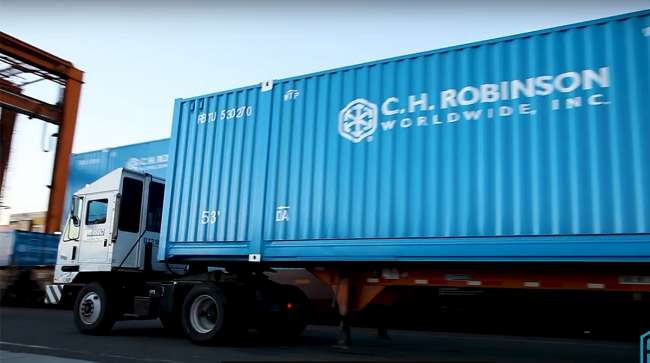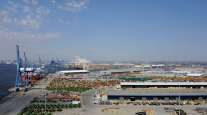Staff Reporter
Dockworkers Strike Would Have Supply Chain Ripple Effect

[Stay on top of transportation news: Get TTNews in your inbox.]
Logistics experts say a threatened strike by U.S. dockworkers could stymie shipping activity that stretches far beyond the East and Gulf Coast ports where work stoppages would occur.
“Historically, ocean carriers tend to wait out strikes, so a port strike could result in thousands of [containers] sitting,” said Mia Ginter, director of North America ocean shipping at C.H. Robinson. “This delay would prevent vessels from calling their next port in Europe, Latin America, etc., putting additional pressure on those ports and potentially leading to backlogs and equipment shortages.”
C.H. Robinson ranks No. 2 on the Transport Topics Top 100 list of the largest logistics companies in North America.
The United States Maritime Alliance (USMX) and the International Longshoremen’s Association (ILA) have been negotiating a new master labor agreement that would cover 45,000 unionized dockworkers at over 30 container ports along the East and Gulf Coasts. But talks have been at an impasse, with the union threatening to strike if a deal is not reached by Oct. 1. And tension is rising; USMX has filed an unfair labor practice charge with the National Labor Relations Board alleging that the ILA is not bargaining in good faith.
9-26-24 USMX_STATEMENT_Update_on_Status_of_USMX-ILA_Negotia…
The maritime alliance also sent a letter to President Joe Biden signed by 177 other trade associations calling for the immediate resumption of negotiations, and accused the union of being unwilling to talk unless all their demands are met.
“Despite additional attempts by USMX to engage with the ILA and resume bargaining, we have been unable to schedule a meeting to continue negotiations,” USMX said in a statement Sept. 23. “We remain prepared to bargain at any time, but both sides must come to the table if we are going to reach a deal, and there is no indication that the ILA is interested in negotiating.”
ILA called the allegations a misleading publicity campaign.
“They call me several times each week trying to get the ILA to accept a lowball wage package,” said Harold Daggett, international president and chief negotiator at ILA. “My ILA members are not going to accept these insulting offers that are a joke considering the work my ILA longshore workers perform, and the billion-dollar profits the companies make off the backs of their labor.”
We commend @JoeBiden for work to mitigate port disruptions & support fair contracts throughout his presidency. With 1 week to a potential #PortStrike, we ask him to demonstrate this leadership by bringing the ILA & USMX to the table https://t.co/cUyleDSD1r — AAFA (@apparelfootwear) September 23, 2024
The stakes for a strike are high. Ginter said that, generally speaking, a week of disruptions at the ports translates to a month of downstream delays. This can result in lengthy recovery times as freight moves inland, which has a ripple effect for companies whether or not they are dealing directly with ocean carriers.

Ginter
She noted industries that rely on a lean inventory model are likely to be the most affected, and said C.H. Robinson has been developing contingency plans with customers for months. Chiefly, this approach has been focused on importing freight early and diversifying what ports are being used, she said.
“The last strike occurred in 1977, a time when global trade was significantly smaller,” Ginter said. “A strike at U.S. ports would result in the closure of 36 ports along the East and Gulf Coasts, including five of the 10 busiest ports in North America.”
Specifically, Project44 warned in a report that with East Coast ports handling approximately 35% to 40% of imports and exports for the U.S., a strike would have serious consequences for global supply chains. The report stressed that certain industries would be disproportionately affected.
I joined @MorningsMaria today to discuss the critical issue of potential port strikes on the East Coast. The ILA is demanding a total ban on automation. The US is lagging behind the world in port automation, we must innovate to remain competitive. https://t.co/7dRNVPApNY — Eric Hoplin (@EricHoplin) September 19, 2024
“I do think that we are likely headed toward a strike,” said Eric Hoplin, president of the National Association of Wholesaler-Distributors. “You’ve got an election coming up here in a couple of weeks, and to have a strike just a couple weeks before the election will exert maximum political pressure.”
Hoplin stressed the importance of supply chain companies being prepared for disruptions, and is confident that wholesalers are prepared with robust inventories and redundant supply chains.
“If one supplier goes down, we have backups,” Hoplin said. “Some of our members are rerouting supplies through the West Coast ports. If you look at the West Coast ports, they’re up in terms of volume by about 20% this year. It’s not all because of this, but it certainly is an indicator that distributors are planning ahead.”
Hoplin stressed that these moves are temporary, and stressed that a strike that drags on for weeks could have a bigger impact.
Ongoing global issues further complicate the risk.
Want more news? Listen to today's daily briefing above or go here for more info
“With the Red Sea disruptions preventing normal access to the Suez Canal and the Panama Canal’s still-reduced capacity, an ILA strike would effectively choke off major arteries of global trade,” said Mike DeAngelis, senior director of international solutions at FourKites. “In anticipation of the strike, shippers have been pulling forward imports and the busy shipping season. But front-loading can only get you so far.”
DeAngelis warned that automotive and agricultural exporters might find themselves in a particularly tight spot.
“A strike could also lead to inventory shortages, potentially impacting holiday shopping seasons and year-end manufacturing targets,” he said. “While West Coast and Canadian ports would see a surge in traffic, they cannot absorb all the volume from the East and Gulf Coast ports. And the influx of freight could cause weeks-, if not monthslong backlogs.”




